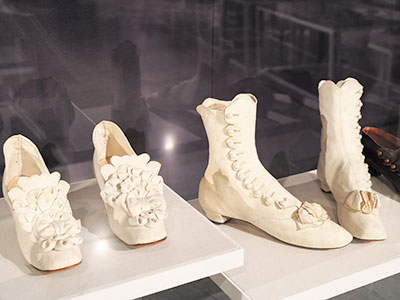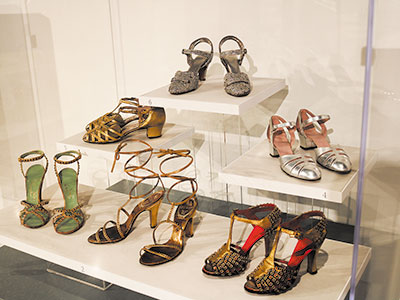The Walk This Way exhibit includes Lola’s red boots from Kinky Boots. (David Taffet/Dallas Voice)
An exhibit of shoes tracks American history
DAVID TAFFET | Senior Staff Writer
taffet@dallasvoice.com
When shoe company owner and designer Stuart Weitzman’s wife bought him a pair of shoes for his birthday, that was the beginning of what became a most impressive collection. But what is the connection to the Dallas Holocaust and Human Rights Museum?
Images of shoes piled outside of Nazi crematoriums come to mind, but this exhibit isn’t gruesome. Instead, this history of the last 200 years of shoes traces American history. So the current exhibition, Walk This Way: Footwear from the Stuart Weitzman Collection of Historic Shoes, is the story of women’s rights.
Well, mostly women’s rights.
In a display case near the entrance of the exhibit is a pair of red boots from the show Kinky Boots, which tells the story of Charlie Price, who recently inherited a shoe factory from his father. Charlie brings the drag queen Lola into the company, and while producing a line of high-heeled red boots, Charlie and Lola save the business and discover they’re not so different at all.
Most of the shoes in the collection were not designed by Weitzman, although one pair is dubbed “Stuart Weitzman’s Million Dollar Shoe.”
Created for a red-carpet event, the diamond-studded shoes were designed to draw attention down to the floor. Until these were worn, only the dress designer was announced as celebrities stopped for photos before entering the Oscars or other star-studded event.

Pegged shoes, above, made for slaves in the early 1800s were held together with wooden pegs to make them easy and cheap to mass produce. (David Taffet/Dallas Voic
The pair on display has had the diamons removed and replaced with fakes.
The oldest shoes included in the collection are from the 1800s: Shoes made for slaves were cheaply pegged together. A marker in the exhibit explains the shoes were “held together with durable wooden pegs and rapidly assembled with little skill,” so they could be made cheaply in mass quantities.
In contrast, also included from that era is a pair of pumps owned by Queen Victoria.
The shoe manufacturing industry was at the center of the industrial revolution. Leather cutting machines were widely used by the 1820s, and sewing machines for leather were introduced in 1852. Lasting and welting machines were introduced in the late 1800s.
Factories, mostly clustered around eastern Massachusetts, put out thousands of shoes a day.
As early as the 1830s, union activity among women shoe stitchers began. The women argued for “fair compensation for their work.” An 1860 strike in Massachusetts protested low wages, and in 1868, the first national union of working women, the Daughters of St. Crispin, was founded and successfully fought wage cuts in 1871.
In the early 20th century, the women’s suffrage movement brought change to women’s shoe design. The first suffrage parade took place in 1910 as hundreds of women marched down 5th Avenue in New York City. Hundreds of marchers grew to thousands before the 19th Amendment was ratified in 1920.
The department stores, especially those lining 5th Avenue, were important institutions in women’s rights. Before 1850, women rarely were seen in public without a male companion. Department stores became a place “respectable women” could socialize, have refreshments and shop. Department stores offered women employment opportunities as sales clerks and as buyers and, in a few cases, even as executives.
“In 1934, Hortense Odlum became the first women to head a major fashion retailer as president of Bonwit Teller,” the exhibit information tells us. That would make Odlum one of the first women to head a company that large.
(And as an odd aside, Trump Tower stands on the site once occupied by Bonwit Teller making his property a landmark in women’s rights history.)

Flashy sandals inspired by the Hollywood epics of the 1940s and ’50s are included in the Weitzman exhibit on display now
Hollywood in the 1940s and ’50s was working under a strict production code that kept on-screen wardrobes very modest. Producers got around the censorship by making biblical pics with actresses clad in skimpy outfits it was imagined they wore at the time.
To accompany the semi-nudity, shoe designers created gold and silver sandals that became fashion trends. On exhibit in Walk This Way are sandals worn by Lana Turner in The Prodigal in 1955 and by Hedy Lamarr in Samson and Delilah in 1949.
The loss of domestic shoe manufacturing to cheap off-shore imports was one of the earliest losses of an entire industry in the 1960s and signaled the beginning of the U.S. to a service economy.
Walk this Way: Footwear from the Stuart Weitzman Collection of Historic Shoes remains on view at the Dallas Holocaust and Human Rights Museum, 300 North Houston St., through July 12. Visit DHHRM.org for information.












